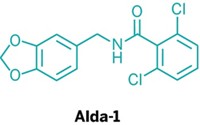Advertisement
Grab your lab coat. Let's get started
Welcome!
Welcome!
Create an account below to get 6 C&EN articles per month, receive newsletters and more - all free.
It seems this is your first time logging in online. Please enter the following information to continue.
As an ACS member you automatically get access to this site. All we need is few more details to create your reading experience.
Not you? Sign in with a different account.
Not you? Sign in with a different account.
ERROR 1
ERROR 1
ERROR 2
ERROR 2
ERROR 2
ERROR 2
ERROR 2
Password and Confirm password must match.
If you have an ACS member number, please enter it here so we can link this account to your membership. (optional)
ERROR 2
ACS values your privacy. By submitting your information, you are gaining access to C&EN and subscribing to our weekly newsletter. We use the information you provide to make your reading experience better, and we will never sell your data to third party members.
Biological Chemistry
Needling Adenosine
Acupuncture appears to stimulate release of the natural painkilling compound
by Sophie L. Rovner
June 7, 2010
| A version of this story appeared in
Volume 88, Issue 23
Acupuncture’s reputed pain-easing benefits appear to derive from the neurotransmitter adenosine and not just from a placebo effect, according to Maiken Nedergaard of the University of Rochester Medical Center and colleagues (Nat. Neurosci., DOI: 10.1038/nn.2562). Studying mice with discomfort induced in one paw, Nedergaard’s team found that acupuncture enhanced the release of adenosine triphosphate. ATP release occurred only if the acupuncture needle was twirled after insertion to cause minor tissue damage, a process that mimics needle manipulation during acupuncture treatment. The researchers determined that the released ATP rapidly degraded to adenosine, a natural painkilling compound that also suppresses inflammation and promotes sleep. The neurotransmitter activated adenosine A1 receptors on pain-transmitting nerve fibers, thereby reducing the nerves’ activity. The team found that the same pain suppression occurred in the absence of acupuncture when the receptors were activated with an injection of 2-chloro-N-cyclopentyladenosine. Furthermore, acupuncture had no effect on pain levels in mice lacking the receptors. The researchers also showed that the leukemia drug deoxycoformycin, which inhibits AMP deaminase and adenosine deaminase, two enzymes that reduce adenosine levels, more than tripled the time that acupuncture’s beneficial effects lasted.






Join the conversation
Contact the reporter
Submit a Letter to the Editor for publication
Engage with us on Twitter